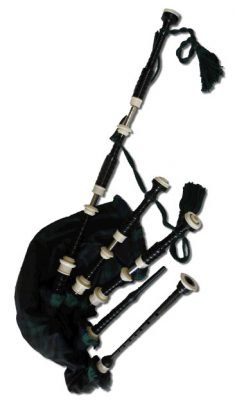 Known already to the ancient Egyptians and Greeks, the bagpipe has passed through the centuries to eventually become the national instrument of Scotland as it remains now. The Great Highland Bagpipe in particular had undergone most of its development during 16-19th centuries in various Scottish regions; whilst the earliest piping competitions date back to 1781 at the annual «Falkirk Tryst» fair, at the time when it was still forbidden for the Highlanders to wear kilts and play «the instrument of war» which the Great Highland Bagpipe was claimed to be.
Known already to the ancient Egyptians and Greeks, the bagpipe has passed through the centuries to eventually become the national instrument of Scotland as it remains now. The Great Highland Bagpipe in particular had undergone most of its development during 16-19th centuries in various Scottish regions; whilst the earliest piping competitions date back to 1781 at the annual «Falkirk Tryst» fair, at the time when it was still forbidden for the Highlanders to wear kilts and play «the instrument of war» which the Great Highland Bagpipe was claimed to be.
The musical peculiarities of the bagpipe have been undergoing changes over the course of the many years of its development, but the playing principle has remained the same. The modern Great Highland Bagpipe consists of a high-pitched pipe with eight playing holes (chanter), a long bass drone (pitched two octaves lower than the chanter) and two tenor drones (both pitched one octave lower than the chanter). The drones produce a constant bass-tenor accompaniment to the chanter and all four pipes are connected to reservoir bag made of sheepskin or hide.
The specific tone of bagpipe music is explained by the functional applications of the instrument dating back to Middle Ages when it served the Highlanders as a ritual and signal instrument. In Scotland they say that the sound of the pipes must combine the human and animal voice and be heard at the range of three miles!
The whole history of Scotland is the saga of its people struggling for freedom, protecting their traditions, habits and character. This struggle toughened the character of the Scots and it was under the music of bagpipes that they fought. The bright, sharp sound of the instrument built up the strength of the warriors, provoked their courage and boosted their morale so important for victory. However they were sadly beaten at Culloden and brutally put down.
The irony of fate was that it was the British which eventually drafted thousands of Highlanders into the Army. The consequent formation of the Scottish Regiments as regular Army forces has actually saved the Great Highland Bagpipe from being forgotten, by allowing the bagpipes to be a part of their everyday duties.. Dating back to 1757 the Scottish Regiments had their own pipers encouraging the soldiers on manoeuvres, and in battles.
Since the introduction of the Bagpipe into the British Army, the repertoire of the instrument has changed. Rather than playing piobaireachd (the classic music for the Great Highland Bagpipes presenting slow and long compositions) the pipers switched to marching and dancing tunes. These in the beginning were folk tunes adapted for playing on the pipes; later on especially composed marches, airs, strathspeys, reels and jigs came into the repertoire.
The Pipers were allocated each to a Company but when on the march combined with the Drummers, which had been the initial marching instrument of the Army, to form a Band.
In that particular way the structure of the modern Pipe Band which we have come to know to-day was established.
Nowadays bagpipes [ just like many other ancient musical instruments of various cultures] are being included into quite a number of modern orchestras and bands, using new musical forms and styles. At the same time, the classic pipe band culture is also on the crest of a wave of popularity with lots of bands being formed worldwide, and joined by more and more people willing to learn playing this wonderful instrument.
One of such bands is ours, «The Pipes & Drums of St. Petersburg».